Food Safety Knowledge, Attitude, Practice: Jordan University Students
VerifiedAdded on 2023/04/21
|47
|14048
|144
Project
AI Summary
This research proposal outlines a study to evaluate the knowledge, attitudes, and practices (KAP) of food safety and handling among students at the University of Jordan. The research aims to assess students' understanding of food hygiene, their behaviors related to food preparation and storage, and their attitudes towards food safety. The study will utilize a questionnaire to gather data, which will then be analyzed statistically to identify any relationships between demographic characteristics and KAP. The research addresses the importance of food safety in preventing foodborne illnesses, especially among young adults, and highlights the limited research on this topic in the Middle East. The expected outcomes include a better understanding of students' current practices and knowledge gaps, which can inform the development of targeted interventions to improve food safety behaviors. The proposal includes a detailed literature review covering foodborne illnesses globally and in the Middle East, as well as existing research on food safety practices among consumers and students. It also details the methodology, including the study design, population, sampling method, data collection instruments, and ethical considerations. The research seeks to contribute to the body of knowledge on food safety and promote healthier practices among university students.
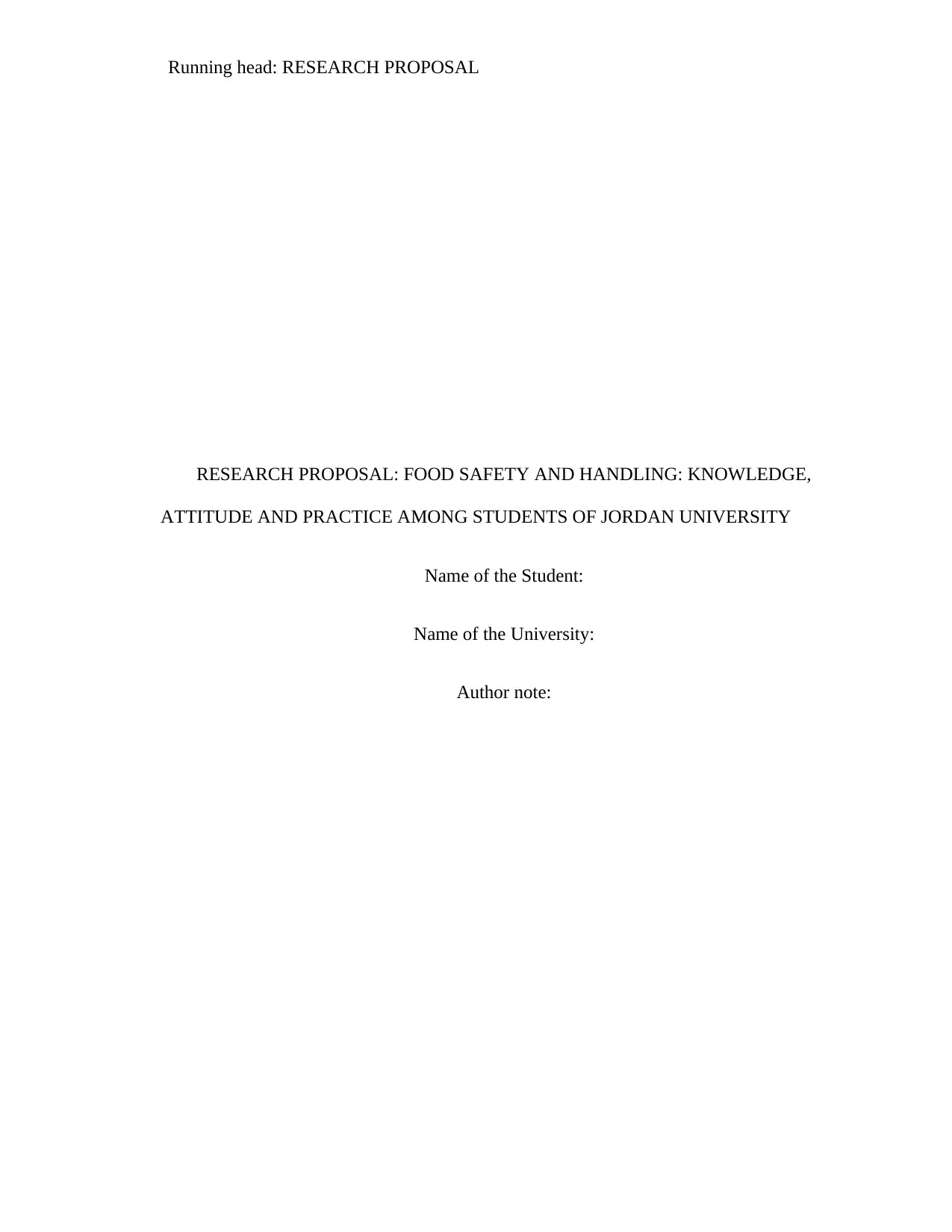
Running head: RESEARCH PROPOSAL
RESEARCH PROPOSAL: FOOD SAFETY AND HANDLING: KNOWLEDGE,
ATTITUDE AND PRACTICE AMONG STUDENTS OF JORDAN UNIVERSITY
Name of the Student:
Name of the University:
Author note:
RESEARCH PROPOSAL: FOOD SAFETY AND HANDLING: KNOWLEDGE,
ATTITUDE AND PRACTICE AMONG STUDENTS OF JORDAN UNIVERSITY
Name of the Student:
Name of the University:
Author note:
Paraphrase This Document
Need a fresh take? Get an instant paraphrase of this document with our AI Paraphraser
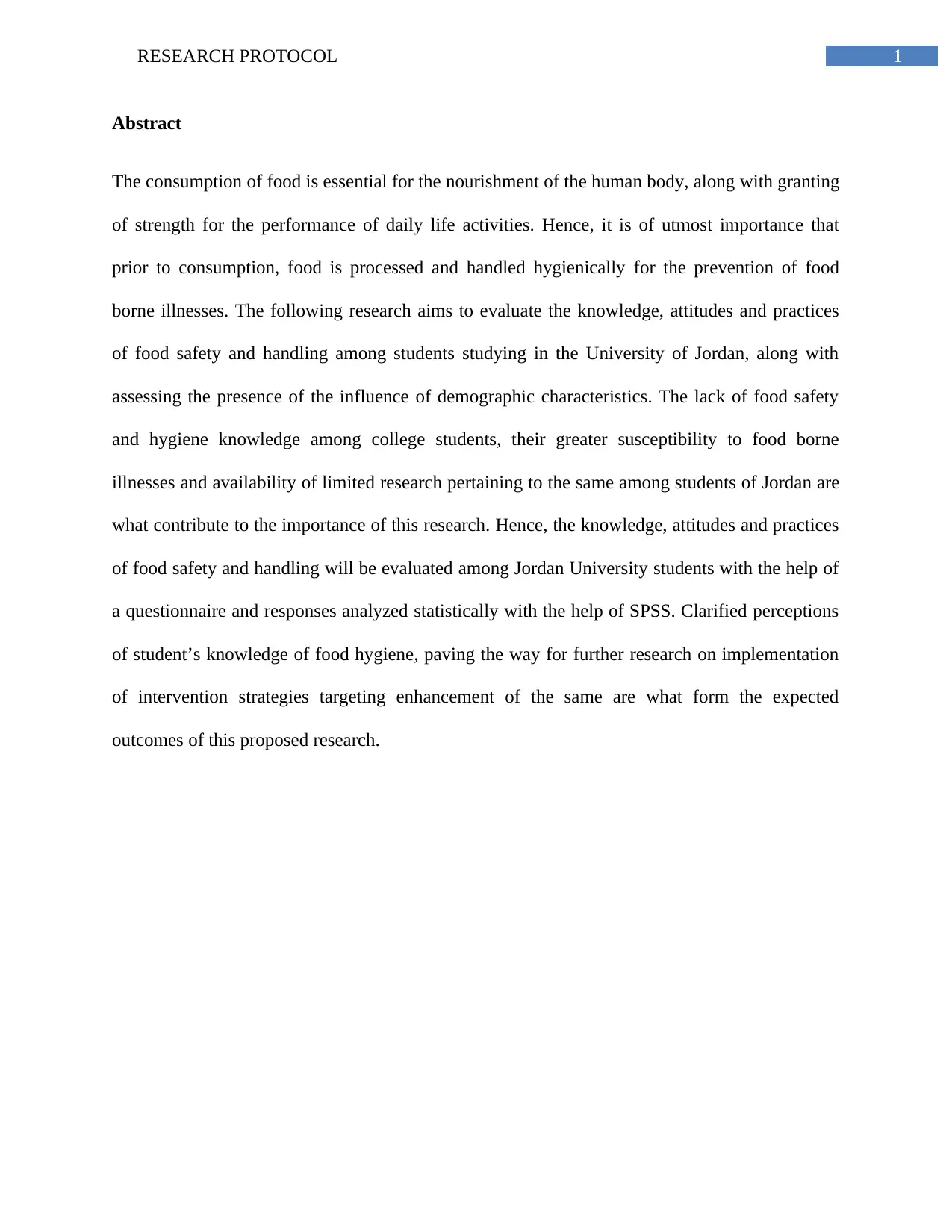
1RESEARCH PROTOCOL
Abstract
The consumption of food is essential for the nourishment of the human body, along with granting
of strength for the performance of daily life activities. Hence, it is of utmost importance that
prior to consumption, food is processed and handled hygienically for the prevention of food
borne illnesses. The following research aims to evaluate the knowledge, attitudes and practices
of food safety and handling among students studying in the University of Jordan, along with
assessing the presence of the influence of demographic characteristics. The lack of food safety
and hygiene knowledge among college students, their greater susceptibility to food borne
illnesses and availability of limited research pertaining to the same among students of Jordan are
what contribute to the importance of this research. Hence, the knowledge, attitudes and practices
of food safety and handling will be evaluated among Jordan University students with the help of
a questionnaire and responses analyzed statistically with the help of SPSS. Clarified perceptions
of student’s knowledge of food hygiene, paving the way for further research on implementation
of intervention strategies targeting enhancement of the same are what form the expected
outcomes of this proposed research.
Abstract
The consumption of food is essential for the nourishment of the human body, along with granting
of strength for the performance of daily life activities. Hence, it is of utmost importance that
prior to consumption, food is processed and handled hygienically for the prevention of food
borne illnesses. The following research aims to evaluate the knowledge, attitudes and practices
of food safety and handling among students studying in the University of Jordan, along with
assessing the presence of the influence of demographic characteristics. The lack of food safety
and hygiene knowledge among college students, their greater susceptibility to food borne
illnesses and availability of limited research pertaining to the same among students of Jordan are
what contribute to the importance of this research. Hence, the knowledge, attitudes and practices
of food safety and handling will be evaluated among Jordan University students with the help of
a questionnaire and responses analyzed statistically with the help of SPSS. Clarified perceptions
of student’s knowledge of food hygiene, paving the way for further research on implementation
of intervention strategies targeting enhancement of the same are what form the expected
outcomes of this proposed research.
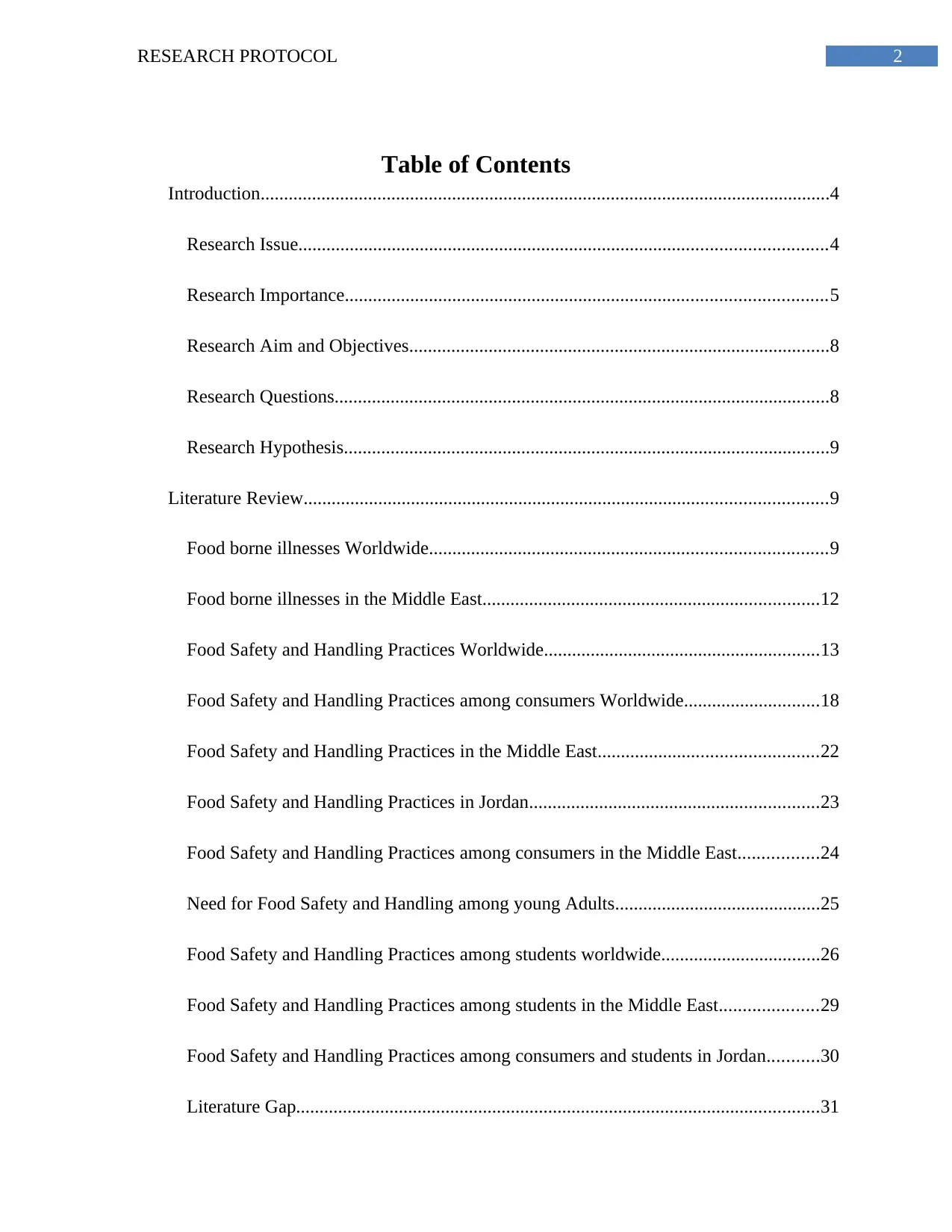
2RESEARCH PROTOCOL
Table of Contents
Introduction..........................................................................................................................4
Research Issue.................................................................................................................4
Research Importance.......................................................................................................5
Research Aim and Objectives..........................................................................................8
Research Questions..........................................................................................................8
Research Hypothesis........................................................................................................9
Literature Review................................................................................................................9
Food borne illnesses Worldwide.....................................................................................9
Food borne illnesses in the Middle East........................................................................12
Food Safety and Handling Practices Worldwide...........................................................13
Food Safety and Handling Practices among consumers Worldwide.............................18
Food Safety and Handling Practices in the Middle East...............................................22
Food Safety and Handling Practices in Jordan..............................................................23
Food Safety and Handling Practices among consumers in the Middle East.................24
Need for Food Safety and Handling among young Adults............................................25
Food Safety and Handling Practices among students worldwide..................................26
Food Safety and Handling Practices among students in the Middle East.....................29
Food Safety and Handling Practices among consumers and students in Jordan...........30
Literature Gap................................................................................................................31
Table of Contents
Introduction..........................................................................................................................4
Research Issue.................................................................................................................4
Research Importance.......................................................................................................5
Research Aim and Objectives..........................................................................................8
Research Questions..........................................................................................................8
Research Hypothesis........................................................................................................9
Literature Review................................................................................................................9
Food borne illnesses Worldwide.....................................................................................9
Food borne illnesses in the Middle East........................................................................12
Food Safety and Handling Practices Worldwide...........................................................13
Food Safety and Handling Practices among consumers Worldwide.............................18
Food Safety and Handling Practices in the Middle East...............................................22
Food Safety and Handling Practices in Jordan..............................................................23
Food Safety and Handling Practices among consumers in the Middle East.................24
Need for Food Safety and Handling among young Adults............................................25
Food Safety and Handling Practices among students worldwide..................................26
Food Safety and Handling Practices among students in the Middle East.....................29
Food Safety and Handling Practices among consumers and students in Jordan...........30
Literature Gap................................................................................................................31
⊘ This is a preview!⊘
Do you want full access?
Subscribe today to unlock all pages.

Trusted by 1+ million students worldwide
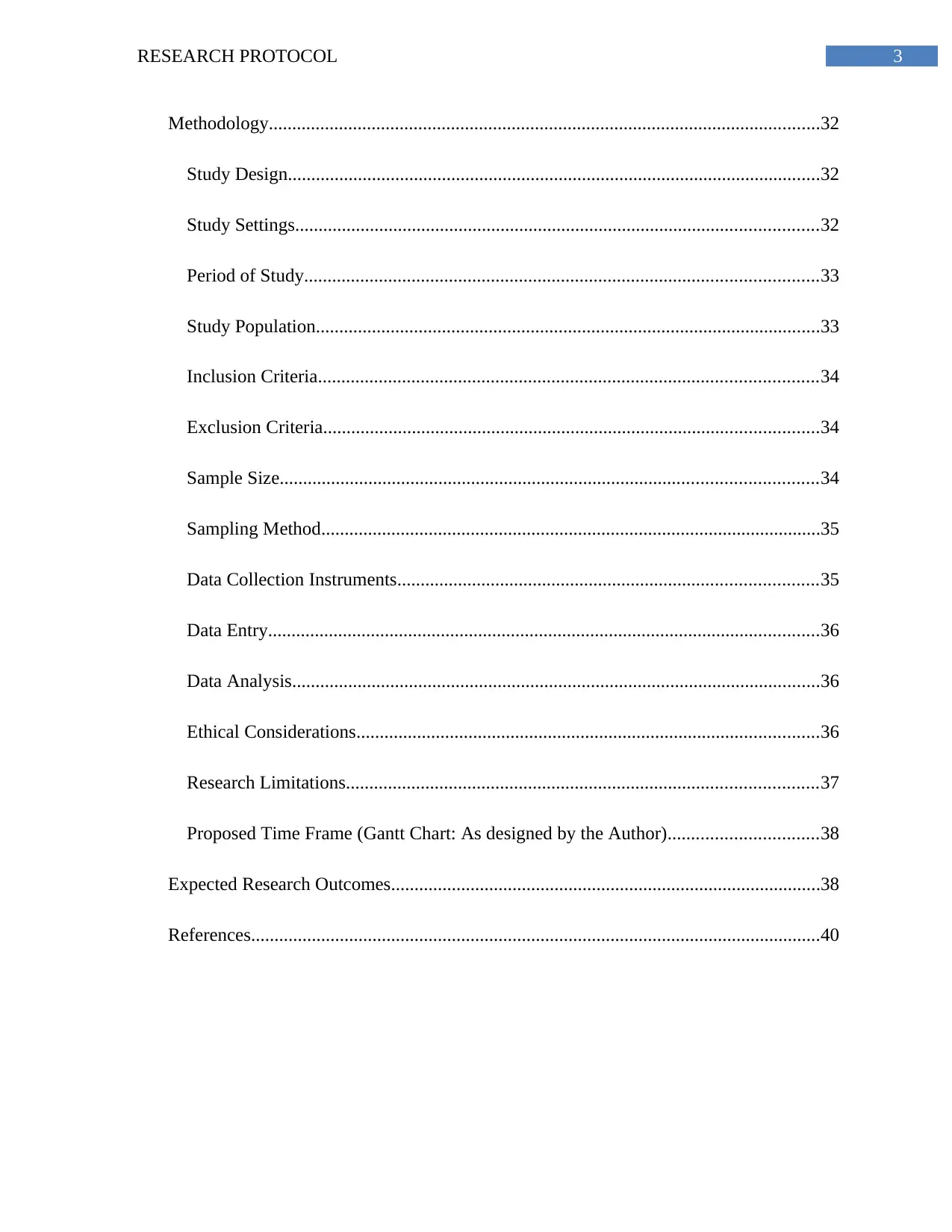
3RESEARCH PROTOCOL
Methodology......................................................................................................................32
Study Design..................................................................................................................32
Study Settings................................................................................................................32
Period of Study..............................................................................................................33
Study Population............................................................................................................33
Inclusion Criteria...........................................................................................................34
Exclusion Criteria..........................................................................................................34
Sample Size...................................................................................................................34
Sampling Method...........................................................................................................35
Data Collection Instruments..........................................................................................35
Data Entry......................................................................................................................36
Data Analysis.................................................................................................................36
Ethical Considerations...................................................................................................36
Research Limitations.....................................................................................................37
Proposed Time Frame (Gantt Chart: As designed by the Author)................................38
Expected Research Outcomes............................................................................................38
References..........................................................................................................................40
Methodology......................................................................................................................32
Study Design..................................................................................................................32
Study Settings................................................................................................................32
Period of Study..............................................................................................................33
Study Population............................................................................................................33
Inclusion Criteria...........................................................................................................34
Exclusion Criteria..........................................................................................................34
Sample Size...................................................................................................................34
Sampling Method...........................................................................................................35
Data Collection Instruments..........................................................................................35
Data Entry......................................................................................................................36
Data Analysis.................................................................................................................36
Ethical Considerations...................................................................................................36
Research Limitations.....................................................................................................37
Proposed Time Frame (Gantt Chart: As designed by the Author)................................38
Expected Research Outcomes............................................................................................38
References..........................................................................................................................40
Paraphrase This Document
Need a fresh take? Get an instant paraphrase of this document with our AI Paraphraser
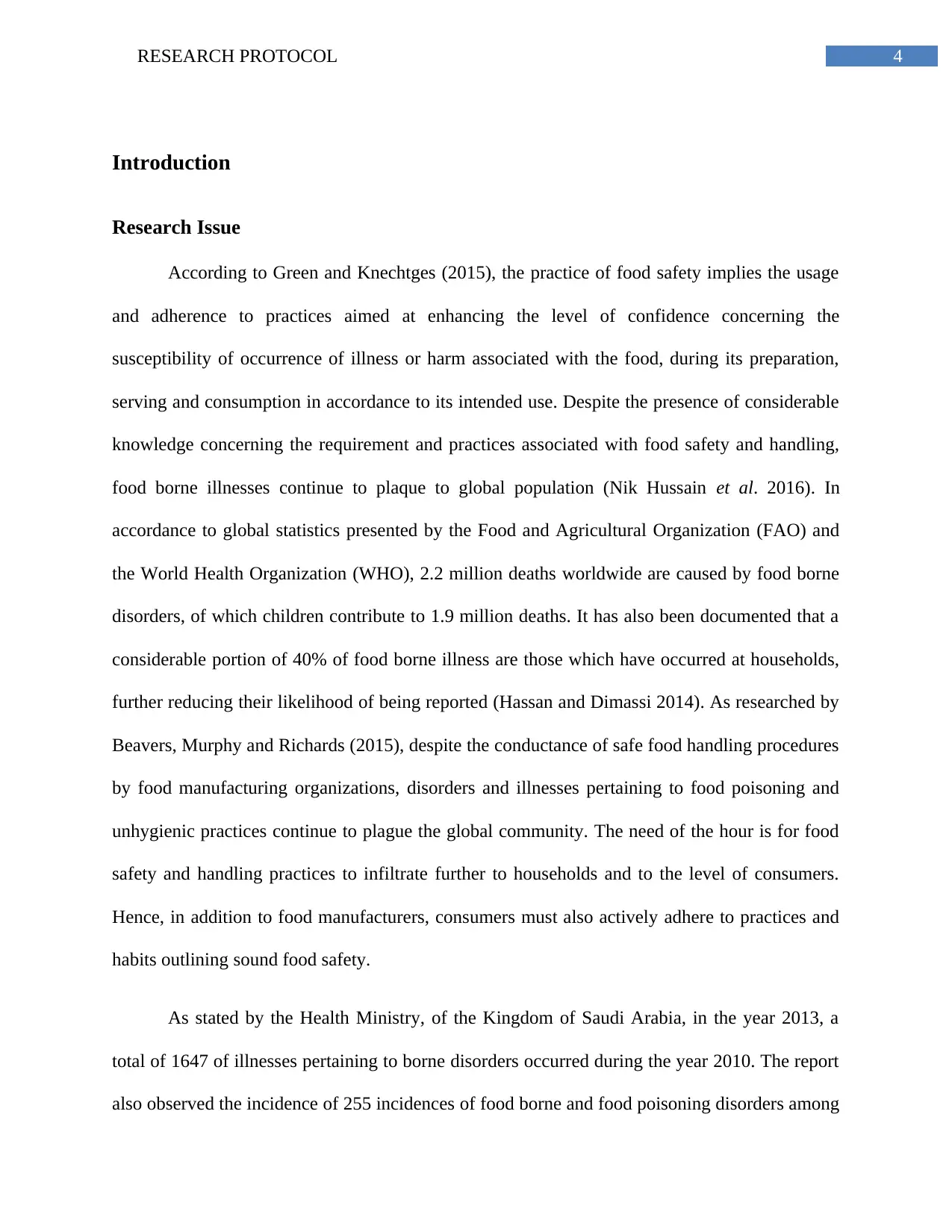
4RESEARCH PROTOCOL
Introduction
Research Issue
According to Green and Knechtges (2015), the practice of food safety implies the usage
and adherence to practices aimed at enhancing the level of confidence concerning the
susceptibility of occurrence of illness or harm associated with the food, during its preparation,
serving and consumption in accordance to its intended use. Despite the presence of considerable
knowledge concerning the requirement and practices associated with food safety and handling,
food borne illnesses continue to plaque to global population (Nik Hussain et al. 2016). In
accordance to global statistics presented by the Food and Agricultural Organization (FAO) and
the World Health Organization (WHO), 2.2 million deaths worldwide are caused by food borne
disorders, of which children contribute to 1.9 million deaths. It has also been documented that a
considerable portion of 40% of food borne illness are those which have occurred at households,
further reducing their likelihood of being reported (Hassan and Dimassi 2014). As researched by
Beavers, Murphy and Richards (2015), despite the conductance of safe food handling procedures
by food manufacturing organizations, disorders and illnesses pertaining to food poisoning and
unhygienic practices continue to plague the global community. The need of the hour is for food
safety and handling practices to infiltrate further to households and to the level of consumers.
Hence, in addition to food manufacturers, consumers must also actively adhere to practices and
habits outlining sound food safety.
As stated by the Health Ministry, of the Kingdom of Saudi Arabia, in the year 2013, a
total of 1647 of illnesses pertaining to borne disorders occurred during the year 2010. The report
also observed the incidence of 255 incidences of food borne and food poisoning disorders among
Introduction
Research Issue
According to Green and Knechtges (2015), the practice of food safety implies the usage
and adherence to practices aimed at enhancing the level of confidence concerning the
susceptibility of occurrence of illness or harm associated with the food, during its preparation,
serving and consumption in accordance to its intended use. Despite the presence of considerable
knowledge concerning the requirement and practices associated with food safety and handling,
food borne illnesses continue to plaque to global population (Nik Hussain et al. 2016). In
accordance to global statistics presented by the Food and Agricultural Organization (FAO) and
the World Health Organization (WHO), 2.2 million deaths worldwide are caused by food borne
disorders, of which children contribute to 1.9 million deaths. It has also been documented that a
considerable portion of 40% of food borne illness are those which have occurred at households,
further reducing their likelihood of being reported (Hassan and Dimassi 2014). As researched by
Beavers, Murphy and Richards (2015), despite the conductance of safe food handling procedures
by food manufacturing organizations, disorders and illnesses pertaining to food poisoning and
unhygienic practices continue to plague the global community. The need of the hour is for food
safety and handling practices to infiltrate further to households and to the level of consumers.
Hence, in addition to food manufacturers, consumers must also actively adhere to practices and
habits outlining sound food safety.
As stated by the Health Ministry, of the Kingdom of Saudi Arabia, in the year 2013, a
total of 1647 of illnesses pertaining to borne disorders occurred during the year 2010. The report
also observed the incidence of 255 incidences of food borne and food poisoning disorders among
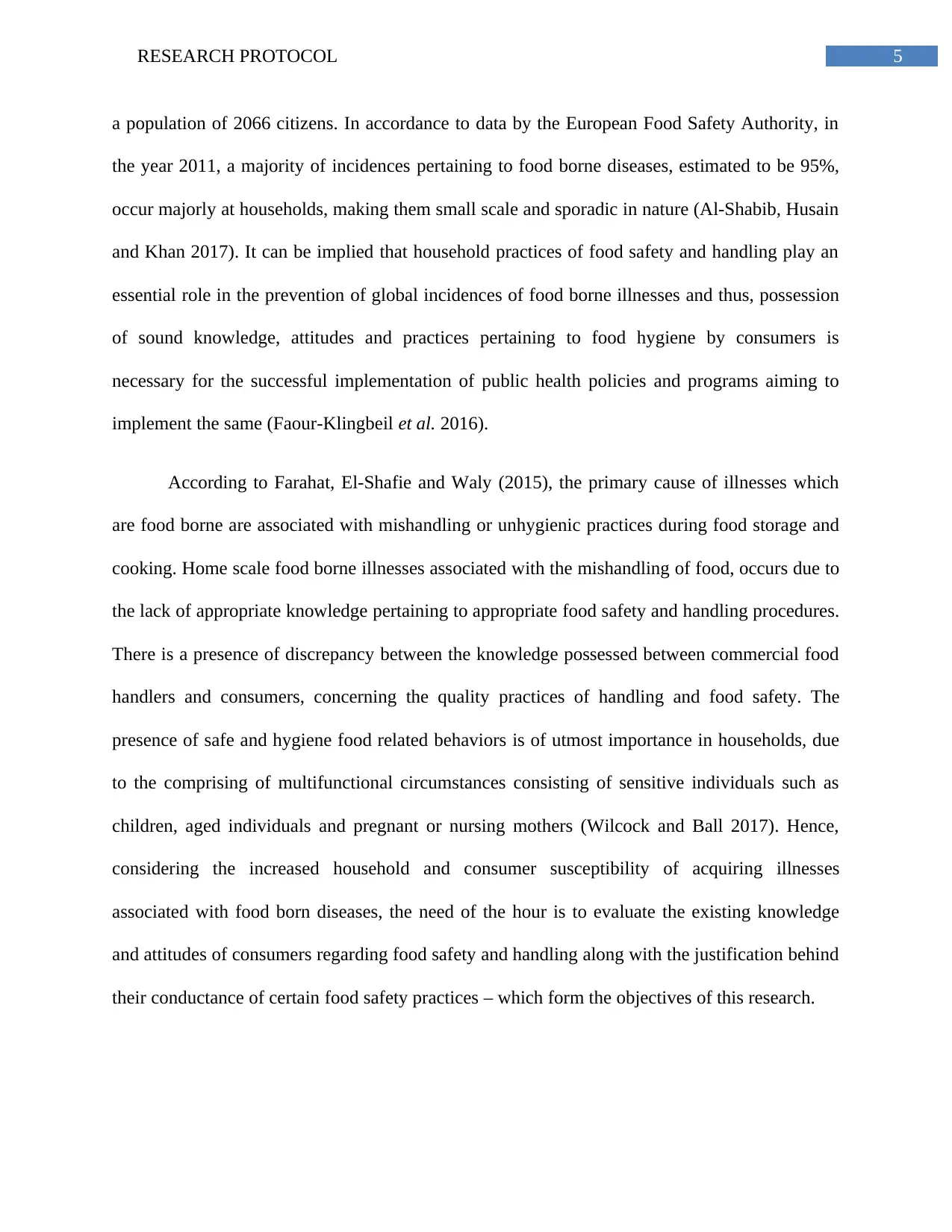
5RESEARCH PROTOCOL
a population of 2066 citizens. In accordance to data by the European Food Safety Authority, in
the year 2011, a majority of incidences pertaining to food borne diseases, estimated to be 95%,
occur majorly at households, making them small scale and sporadic in nature (Al-Shabib, Husain
and Khan 2017). It can be implied that household practices of food safety and handling play an
essential role in the prevention of global incidences of food borne illnesses and thus, possession
of sound knowledge, attitudes and practices pertaining to food hygiene by consumers is
necessary for the successful implementation of public health policies and programs aiming to
implement the same (Faour-Klingbeil et al. 2016).
According to Farahat, El-Shafie and Waly (2015), the primary cause of illnesses which
are food borne are associated with mishandling or unhygienic practices during food storage and
cooking. Home scale food borne illnesses associated with the mishandling of food, occurs due to
the lack of appropriate knowledge pertaining to appropriate food safety and handling procedures.
There is a presence of discrepancy between the knowledge possessed between commercial food
handlers and consumers, concerning the quality practices of handling and food safety. The
presence of safe and hygiene food related behaviors is of utmost importance in households, due
to the comprising of multifunctional circumstances consisting of sensitive individuals such as
children, aged individuals and pregnant or nursing mothers (Wilcock and Ball 2017). Hence,
considering the increased household and consumer susceptibility of acquiring illnesses
associated with food born diseases, the need of the hour is to evaluate the existing knowledge
and attitudes of consumers regarding food safety and handling along with the justification behind
their conductance of certain food safety practices – which form the objectives of this research.
a population of 2066 citizens. In accordance to data by the European Food Safety Authority, in
the year 2011, a majority of incidences pertaining to food borne diseases, estimated to be 95%,
occur majorly at households, making them small scale and sporadic in nature (Al-Shabib, Husain
and Khan 2017). It can be implied that household practices of food safety and handling play an
essential role in the prevention of global incidences of food borne illnesses and thus, possession
of sound knowledge, attitudes and practices pertaining to food hygiene by consumers is
necessary for the successful implementation of public health policies and programs aiming to
implement the same (Faour-Klingbeil et al. 2016).
According to Farahat, El-Shafie and Waly (2015), the primary cause of illnesses which
are food borne are associated with mishandling or unhygienic practices during food storage and
cooking. Home scale food borne illnesses associated with the mishandling of food, occurs due to
the lack of appropriate knowledge pertaining to appropriate food safety and handling procedures.
There is a presence of discrepancy between the knowledge possessed between commercial food
handlers and consumers, concerning the quality practices of handling and food safety. The
presence of safe and hygiene food related behaviors is of utmost importance in households, due
to the comprising of multifunctional circumstances consisting of sensitive individuals such as
children, aged individuals and pregnant or nursing mothers (Wilcock and Ball 2017). Hence,
considering the increased household and consumer susceptibility of acquiring illnesses
associated with food born diseases, the need of the hour is to evaluate the existing knowledge
and attitudes of consumers regarding food safety and handling along with the justification behind
their conductance of certain food safety practices – which form the objectives of this research.
⊘ This is a preview!⊘
Do you want full access?
Subscribe today to unlock all pages.

Trusted by 1+ million students worldwide
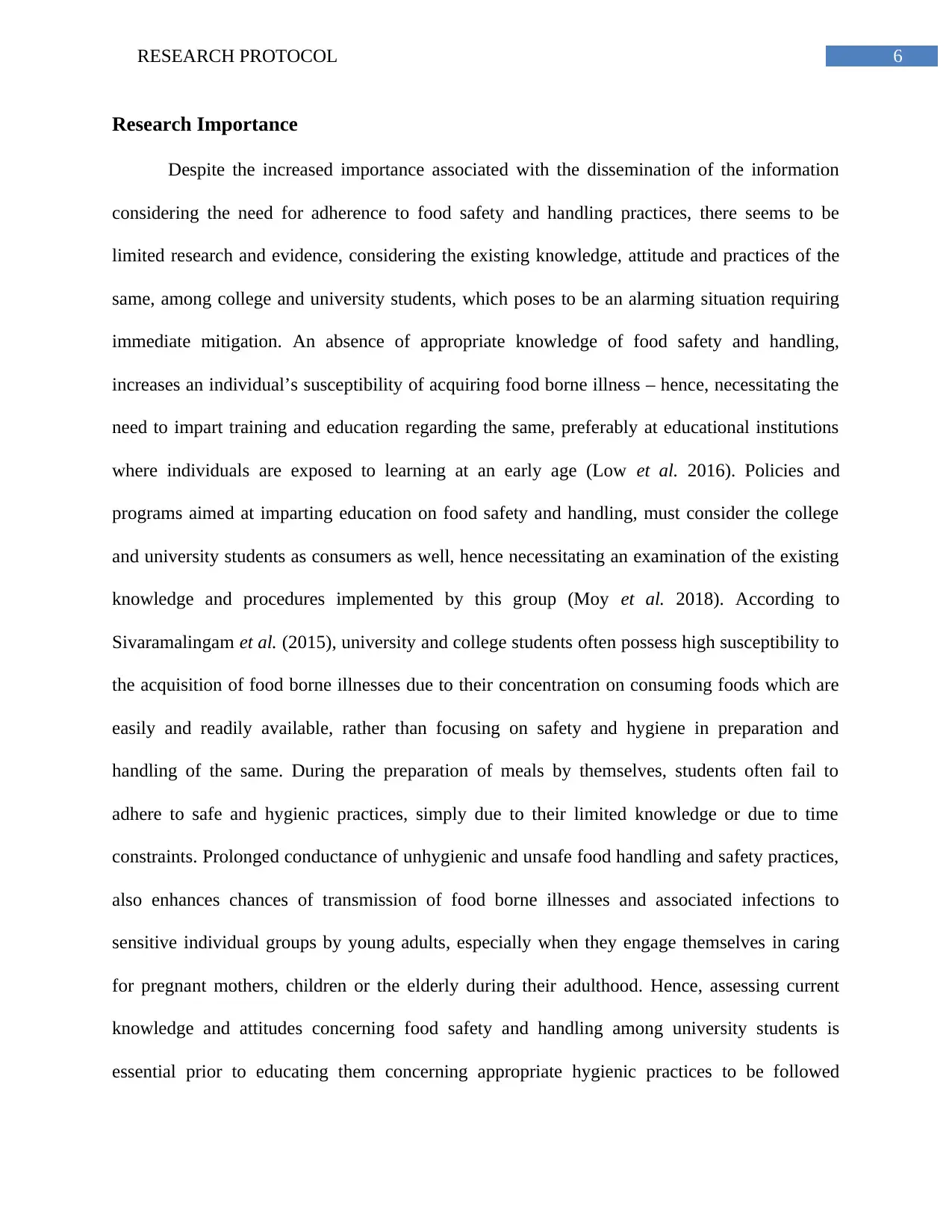
6RESEARCH PROTOCOL
Research Importance
Despite the increased importance associated with the dissemination of the information
considering the need for adherence to food safety and handling practices, there seems to be
limited research and evidence, considering the existing knowledge, attitude and practices of the
same, among college and university students, which poses to be an alarming situation requiring
immediate mitigation. An absence of appropriate knowledge of food safety and handling,
increases an individual’s susceptibility of acquiring food borne illness – hence, necessitating the
need to impart training and education regarding the same, preferably at educational institutions
where individuals are exposed to learning at an early age (Low et al. 2016). Policies and
programs aimed at imparting education on food safety and handling, must consider the college
and university students as consumers as well, hence necessitating an examination of the existing
knowledge and procedures implemented by this group (Moy et al. 2018). According to
Sivaramalingam et al. (2015), university and college students often possess high susceptibility to
the acquisition of food borne illnesses due to their concentration on consuming foods which are
easily and readily available, rather than focusing on safety and hygiene in preparation and
handling of the same. During the preparation of meals by themselves, students often fail to
adhere to safe and hygienic practices, simply due to their limited knowledge or due to time
constraints. Prolonged conductance of unhygienic and unsafe food handling and safety practices,
also enhances chances of transmission of food borne illnesses and associated infections to
sensitive individual groups by young adults, especially when they engage themselves in caring
for pregnant mothers, children or the elderly during their adulthood. Hence, assessing current
knowledge and attitudes concerning food safety and handling among university students is
essential prior to educating them concerning appropriate hygienic practices to be followed
Research Importance
Despite the increased importance associated with the dissemination of the information
considering the need for adherence to food safety and handling practices, there seems to be
limited research and evidence, considering the existing knowledge, attitude and practices of the
same, among college and university students, which poses to be an alarming situation requiring
immediate mitigation. An absence of appropriate knowledge of food safety and handling,
increases an individual’s susceptibility of acquiring food borne illness – hence, necessitating the
need to impart training and education regarding the same, preferably at educational institutions
where individuals are exposed to learning at an early age (Low et al. 2016). Policies and
programs aimed at imparting education on food safety and handling, must consider the college
and university students as consumers as well, hence necessitating an examination of the existing
knowledge and procedures implemented by this group (Moy et al. 2018). According to
Sivaramalingam et al. (2015), university and college students often possess high susceptibility to
the acquisition of food borne illnesses due to their concentration on consuming foods which are
easily and readily available, rather than focusing on safety and hygiene in preparation and
handling of the same. During the preparation of meals by themselves, students often fail to
adhere to safe and hygienic practices, simply due to their limited knowledge or due to time
constraints. Prolonged conductance of unhygienic and unsafe food handling and safety practices,
also enhances chances of transmission of food borne illnesses and associated infections to
sensitive individual groups by young adults, especially when they engage themselves in caring
for pregnant mothers, children or the elderly during their adulthood. Hence, assessing current
knowledge and attitudes concerning food safety and handling among university students is
essential prior to educating them concerning appropriate hygienic practices to be followed
Paraphrase This Document
Need a fresh take? Get an instant paraphrase of this document with our AI Paraphraser
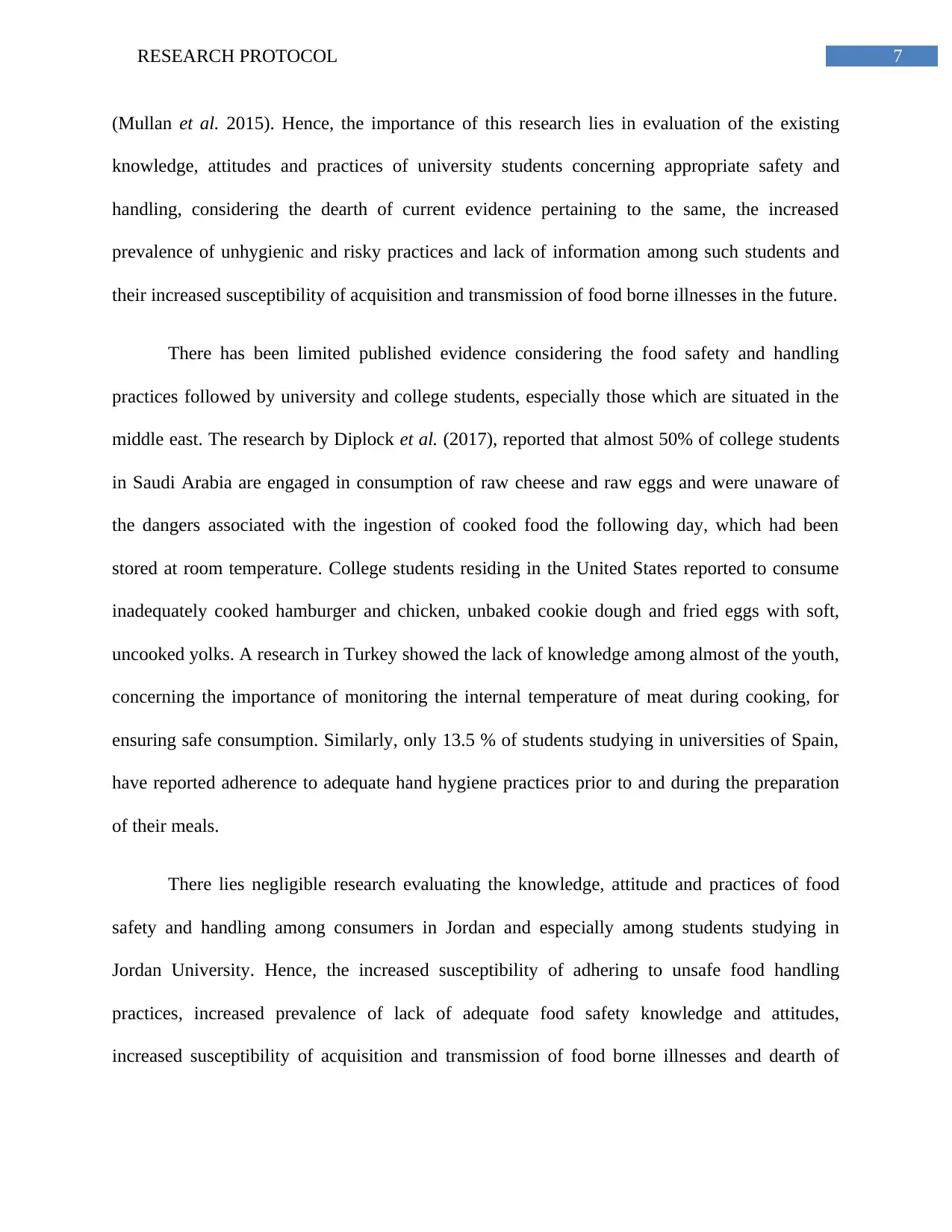
7RESEARCH PROTOCOL
(Mullan et al. 2015). Hence, the importance of this research lies in evaluation of the existing
knowledge, attitudes and practices of university students concerning appropriate safety and
handling, considering the dearth of current evidence pertaining to the same, the increased
prevalence of unhygienic and risky practices and lack of information among such students and
their increased susceptibility of acquisition and transmission of food borne illnesses in the future.
There has been limited published evidence considering the food safety and handling
practices followed by university and college students, especially those which are situated in the
middle east. The research by Diplock et al. (2017), reported that almost 50% of college students
in Saudi Arabia are engaged in consumption of raw cheese and raw eggs and were unaware of
the dangers associated with the ingestion of cooked food the following day, which had been
stored at room temperature. College students residing in the United States reported to consume
inadequately cooked hamburger and chicken, unbaked cookie dough and fried eggs with soft,
uncooked yolks. A research in Turkey showed the lack of knowledge among almost of the youth,
concerning the importance of monitoring the internal temperature of meat during cooking, for
ensuring safe consumption. Similarly, only 13.5 % of students studying in universities of Spain,
have reported adherence to adequate hand hygiene practices prior to and during the preparation
of their meals.
There lies negligible research evaluating the knowledge, attitude and practices of food
safety and handling among consumers in Jordan and especially among students studying in
Jordan University. Hence, the increased susceptibility of adhering to unsafe food handling
practices, increased prevalence of lack of adequate food safety knowledge and attitudes,
increased susceptibility of acquisition and transmission of food borne illnesses and dearth of
(Mullan et al. 2015). Hence, the importance of this research lies in evaluation of the existing
knowledge, attitudes and practices of university students concerning appropriate safety and
handling, considering the dearth of current evidence pertaining to the same, the increased
prevalence of unhygienic and risky practices and lack of information among such students and
their increased susceptibility of acquisition and transmission of food borne illnesses in the future.
There has been limited published evidence considering the food safety and handling
practices followed by university and college students, especially those which are situated in the
middle east. The research by Diplock et al. (2017), reported that almost 50% of college students
in Saudi Arabia are engaged in consumption of raw cheese and raw eggs and were unaware of
the dangers associated with the ingestion of cooked food the following day, which had been
stored at room temperature. College students residing in the United States reported to consume
inadequately cooked hamburger and chicken, unbaked cookie dough and fried eggs with soft,
uncooked yolks. A research in Turkey showed the lack of knowledge among almost of the youth,
concerning the importance of monitoring the internal temperature of meat during cooking, for
ensuring safe consumption. Similarly, only 13.5 % of students studying in universities of Spain,
have reported adherence to adequate hand hygiene practices prior to and during the preparation
of their meals.
There lies negligible research evaluating the knowledge, attitude and practices of food
safety and handling among consumers in Jordan and especially among students studying in
Jordan University. Hence, the increased susceptibility of adhering to unsafe food handling
practices, increased prevalence of lack of adequate food safety knowledge and attitudes,
increased susceptibility of acquisition and transmission of food borne illnesses and dearth of
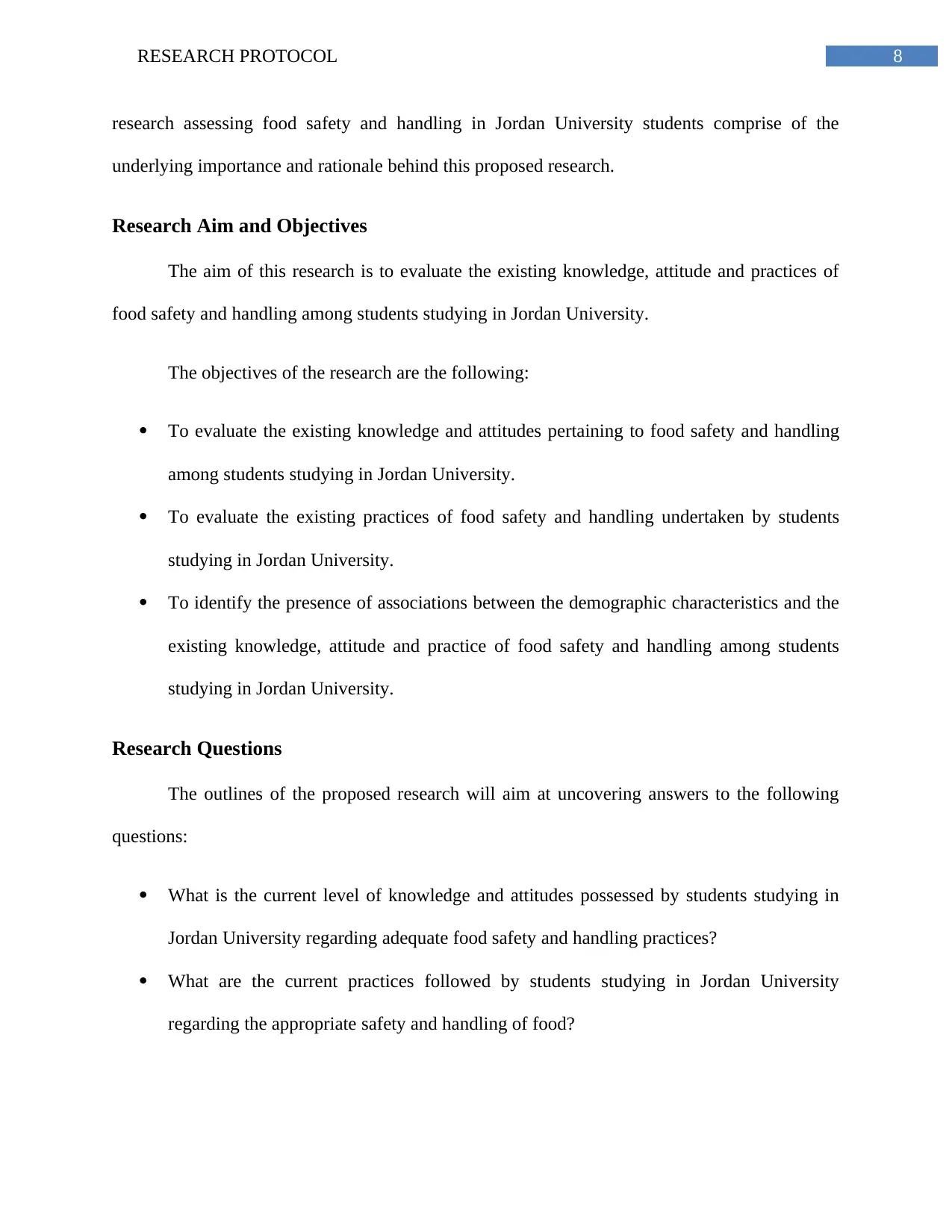
8RESEARCH PROTOCOL
research assessing food safety and handling in Jordan University students comprise of the
underlying importance and rationale behind this proposed research.
Research Aim and Objectives
The aim of this research is to evaluate the existing knowledge, attitude and practices of
food safety and handling among students studying in Jordan University.
The objectives of the research are the following:
To evaluate the existing knowledge and attitudes pertaining to food safety and handling
among students studying in Jordan University.
To evaluate the existing practices of food safety and handling undertaken by students
studying in Jordan University.
To identify the presence of associations between the demographic characteristics and the
existing knowledge, attitude and practice of food safety and handling among students
studying in Jordan University.
Research Questions
The outlines of the proposed research will aim at uncovering answers to the following
questions:
What is the current level of knowledge and attitudes possessed by students studying in
Jordan University regarding adequate food safety and handling practices?
What are the current practices followed by students studying in Jordan University
regarding the appropriate safety and handling of food?
research assessing food safety and handling in Jordan University students comprise of the
underlying importance and rationale behind this proposed research.
Research Aim and Objectives
The aim of this research is to evaluate the existing knowledge, attitude and practices of
food safety and handling among students studying in Jordan University.
The objectives of the research are the following:
To evaluate the existing knowledge and attitudes pertaining to food safety and handling
among students studying in Jordan University.
To evaluate the existing practices of food safety and handling undertaken by students
studying in Jordan University.
To identify the presence of associations between the demographic characteristics and the
existing knowledge, attitude and practice of food safety and handling among students
studying in Jordan University.
Research Questions
The outlines of the proposed research will aim at uncovering answers to the following
questions:
What is the current level of knowledge and attitudes possessed by students studying in
Jordan University regarding adequate food safety and handling practices?
What are the current practices followed by students studying in Jordan University
regarding the appropriate safety and handling of food?
⊘ This is a preview!⊘
Do you want full access?
Subscribe today to unlock all pages.

Trusted by 1+ million students worldwide
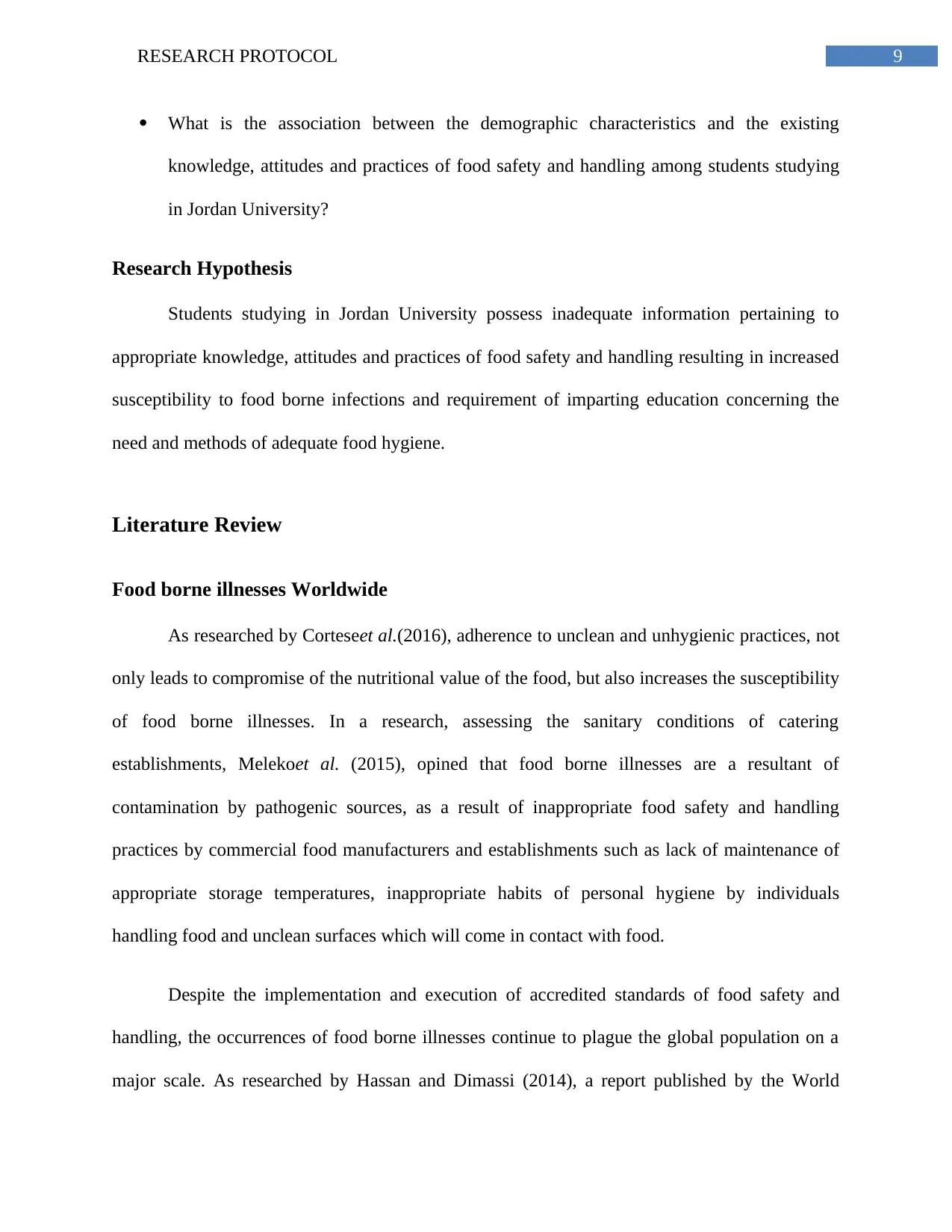
9RESEARCH PROTOCOL
What is the association between the demographic characteristics and the existing
knowledge, attitudes and practices of food safety and handling among students studying
in Jordan University?
Research Hypothesis
Students studying in Jordan University possess inadequate information pertaining to
appropriate knowledge, attitudes and practices of food safety and handling resulting in increased
susceptibility to food borne infections and requirement of imparting education concerning the
need and methods of adequate food hygiene.
Literature Review
Food borne illnesses Worldwide
As researched by Corteseet al.(2016), adherence to unclean and unhygienic practices, not
only leads to compromise of the nutritional value of the food, but also increases the susceptibility
of food borne illnesses. In a research, assessing the sanitary conditions of catering
establishments, Melekoet al. (2015), opined that food borne illnesses are a resultant of
contamination by pathogenic sources, as a result of inappropriate food safety and handling
practices by commercial food manufacturers and establishments such as lack of maintenance of
appropriate storage temperatures, inappropriate habits of personal hygiene by individuals
handling food and unclean surfaces which will come in contact with food.
Despite the implementation and execution of accredited standards of food safety and
handling, the occurrences of food borne illnesses continue to plague the global population on a
major scale. As researched by Hassan and Dimassi (2014), a report published by the World
What is the association between the demographic characteristics and the existing
knowledge, attitudes and practices of food safety and handling among students studying
in Jordan University?
Research Hypothesis
Students studying in Jordan University possess inadequate information pertaining to
appropriate knowledge, attitudes and practices of food safety and handling resulting in increased
susceptibility to food borne infections and requirement of imparting education concerning the
need and methods of adequate food hygiene.
Literature Review
Food borne illnesses Worldwide
As researched by Corteseet al.(2016), adherence to unclean and unhygienic practices, not
only leads to compromise of the nutritional value of the food, but also increases the susceptibility
of food borne illnesses. In a research, assessing the sanitary conditions of catering
establishments, Melekoet al. (2015), opined that food borne illnesses are a resultant of
contamination by pathogenic sources, as a result of inappropriate food safety and handling
practices by commercial food manufacturers and establishments such as lack of maintenance of
appropriate storage temperatures, inappropriate habits of personal hygiene by individuals
handling food and unclean surfaces which will come in contact with food.
Despite the implementation and execution of accredited standards of food safety and
handling, the occurrences of food borne illnesses continue to plague the global population on a
major scale. As researched by Hassan and Dimassi (2014), a report published by the World
Paraphrase This Document
Need a fresh take? Get an instant paraphrase of this document with our AI Paraphraser
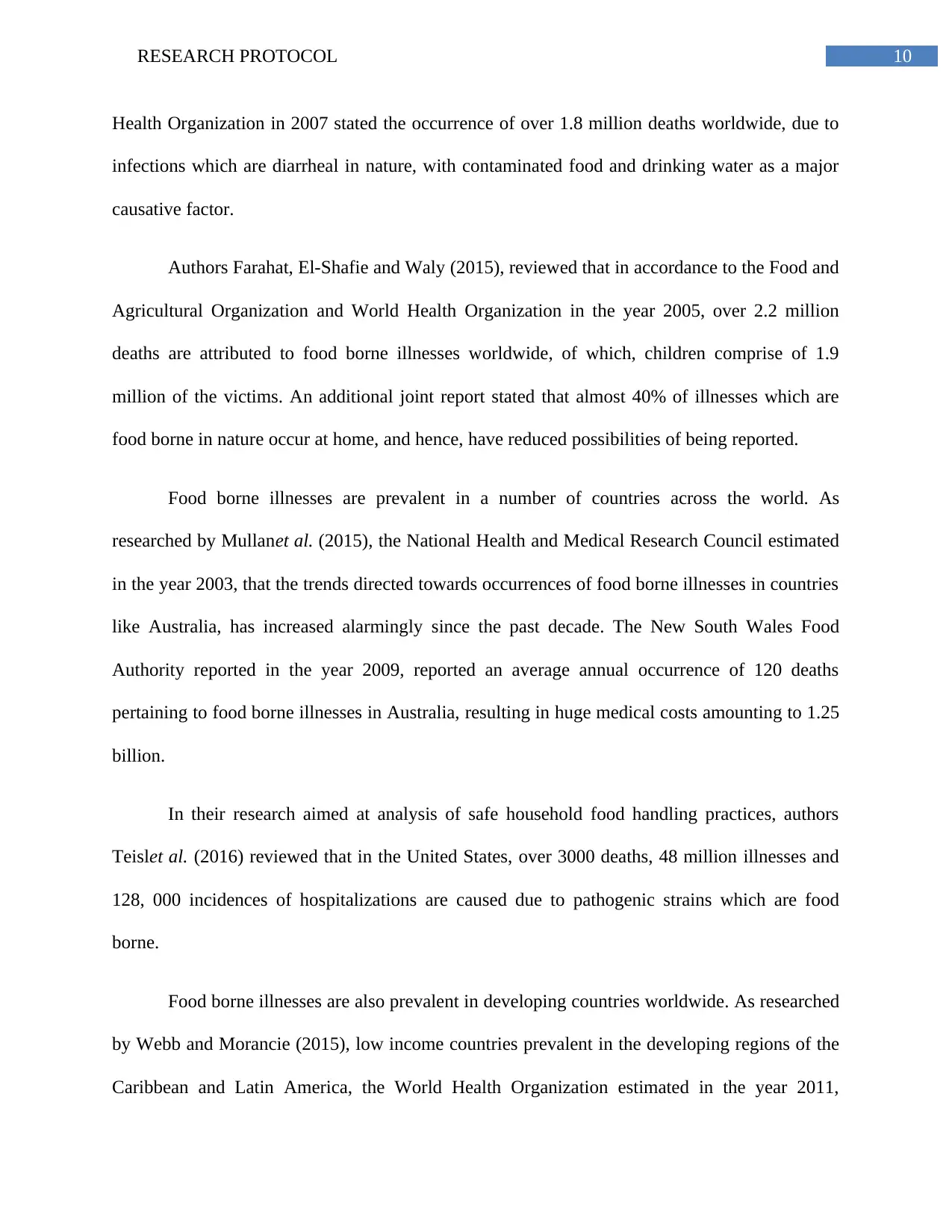
10RESEARCH PROTOCOL
Health Organization in 2007 stated the occurrence of over 1.8 million deaths worldwide, due to
infections which are diarrheal in nature, with contaminated food and drinking water as a major
causative factor.
Authors Farahat, El-Shafie and Waly (2015), reviewed that in accordance to the Food and
Agricultural Organization and World Health Organization in the year 2005, over 2.2 million
deaths are attributed to food borne illnesses worldwide, of which, children comprise of 1.9
million of the victims. An additional joint report stated that almost 40% of illnesses which are
food borne in nature occur at home, and hence, have reduced possibilities of being reported.
Food borne illnesses are prevalent in a number of countries across the world. As
researched by Mullanet al. (2015), the National Health and Medical Research Council estimated
in the year 2003, that the trends directed towards occurrences of food borne illnesses in countries
like Australia, has increased alarmingly since the past decade. The New South Wales Food
Authority reported in the year 2009, reported an average annual occurrence of 120 deaths
pertaining to food borne illnesses in Australia, resulting in huge medical costs amounting to 1.25
billion.
In their research aimed at analysis of safe household food handling practices, authors
Teislet al. (2016) reviewed that in the United States, over 3000 deaths, 48 million illnesses and
128, 000 incidences of hospitalizations are caused due to pathogenic strains which are food
borne.
Food borne illnesses are also prevalent in developing countries worldwide. As researched
by Webb and Morancie (2015), low income countries prevalent in the developing regions of the
Caribbean and Latin America, the World Health Organization estimated in the year 2011,
Health Organization in 2007 stated the occurrence of over 1.8 million deaths worldwide, due to
infections which are diarrheal in nature, with contaminated food and drinking water as a major
causative factor.
Authors Farahat, El-Shafie and Waly (2015), reviewed that in accordance to the Food and
Agricultural Organization and World Health Organization in the year 2005, over 2.2 million
deaths are attributed to food borne illnesses worldwide, of which, children comprise of 1.9
million of the victims. An additional joint report stated that almost 40% of illnesses which are
food borne in nature occur at home, and hence, have reduced possibilities of being reported.
Food borne illnesses are prevalent in a number of countries across the world. As
researched by Mullanet al. (2015), the National Health and Medical Research Council estimated
in the year 2003, that the trends directed towards occurrences of food borne illnesses in countries
like Australia, has increased alarmingly since the past decade. The New South Wales Food
Authority reported in the year 2009, reported an average annual occurrence of 120 deaths
pertaining to food borne illnesses in Australia, resulting in huge medical costs amounting to 1.25
billion.
In their research aimed at analysis of safe household food handling practices, authors
Teislet al. (2016) reviewed that in the United States, over 3000 deaths, 48 million illnesses and
128, 000 incidences of hospitalizations are caused due to pathogenic strains which are food
borne.
Food borne illnesses are also prevalent in developing countries worldwide. As researched
by Webb and Morancie (2015), low income countries prevalent in the developing regions of the
Caribbean and Latin America, the World Health Organization estimated in the year 2011,
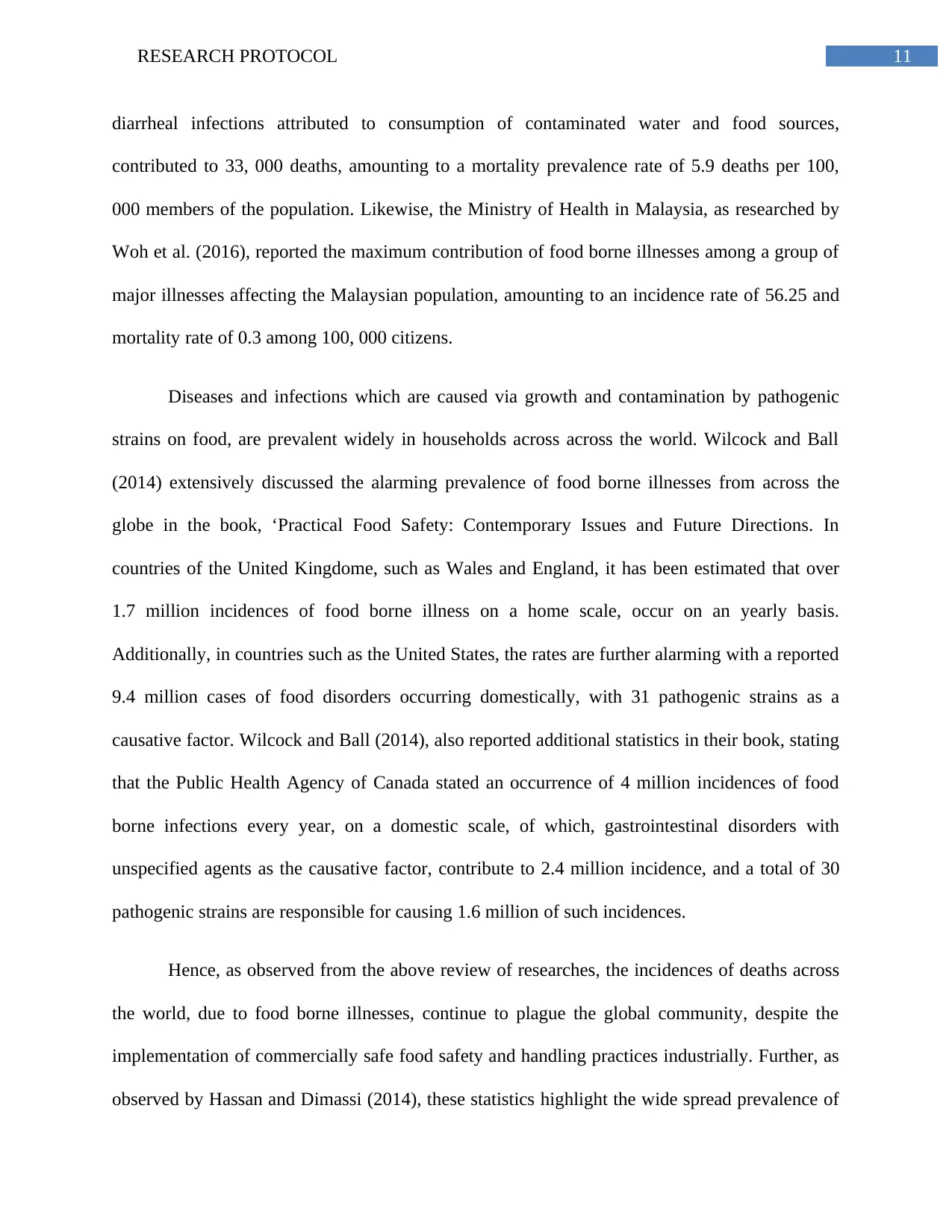
11RESEARCH PROTOCOL
diarrheal infections attributed to consumption of contaminated water and food sources,
contributed to 33, 000 deaths, amounting to a mortality prevalence rate of 5.9 deaths per 100,
000 members of the population. Likewise, the Ministry of Health in Malaysia, as researched by
Woh et al. (2016), reported the maximum contribution of food borne illnesses among a group of
major illnesses affecting the Malaysian population, amounting to an incidence rate of 56.25 and
mortality rate of 0.3 among 100, 000 citizens.
Diseases and infections which are caused via growth and contamination by pathogenic
strains on food, are prevalent widely in households across across the world. Wilcock and Ball
(2014) extensively discussed the alarming prevalence of food borne illnesses from across the
globe in the book, ‘Practical Food Safety: Contemporary Issues and Future Directions. In
countries of the United Kingdome, such as Wales and England, it has been estimated that over
1.7 million incidences of food borne illness on a home scale, occur on an yearly basis.
Additionally, in countries such as the United States, the rates are further alarming with a reported
9.4 million cases of food disorders occurring domestically, with 31 pathogenic strains as a
causative factor. Wilcock and Ball (2014), also reported additional statistics in their book, stating
that the Public Health Agency of Canada stated an occurrence of 4 million incidences of food
borne infections every year, on a domestic scale, of which, gastrointestinal disorders with
unspecified agents as the causative factor, contribute to 2.4 million incidence, and a total of 30
pathogenic strains are responsible for causing 1.6 million of such incidences.
Hence, as observed from the above review of researches, the incidences of deaths across
the world, due to food borne illnesses, continue to plague the global community, despite the
implementation of commercially safe food safety and handling practices industrially. Further, as
observed by Hassan and Dimassi (2014), these statistics highlight the wide spread prevalence of
diarrheal infections attributed to consumption of contaminated water and food sources,
contributed to 33, 000 deaths, amounting to a mortality prevalence rate of 5.9 deaths per 100,
000 members of the population. Likewise, the Ministry of Health in Malaysia, as researched by
Woh et al. (2016), reported the maximum contribution of food borne illnesses among a group of
major illnesses affecting the Malaysian population, amounting to an incidence rate of 56.25 and
mortality rate of 0.3 among 100, 000 citizens.
Diseases and infections which are caused via growth and contamination by pathogenic
strains on food, are prevalent widely in households across across the world. Wilcock and Ball
(2014) extensively discussed the alarming prevalence of food borne illnesses from across the
globe in the book, ‘Practical Food Safety: Contemporary Issues and Future Directions. In
countries of the United Kingdome, such as Wales and England, it has been estimated that over
1.7 million incidences of food borne illness on a home scale, occur on an yearly basis.
Additionally, in countries such as the United States, the rates are further alarming with a reported
9.4 million cases of food disorders occurring domestically, with 31 pathogenic strains as a
causative factor. Wilcock and Ball (2014), also reported additional statistics in their book, stating
that the Public Health Agency of Canada stated an occurrence of 4 million incidences of food
borne infections every year, on a domestic scale, of which, gastrointestinal disorders with
unspecified agents as the causative factor, contribute to 2.4 million incidence, and a total of 30
pathogenic strains are responsible for causing 1.6 million of such incidences.
Hence, as observed from the above review of researches, the incidences of deaths across
the world, due to food borne illnesses, continue to plague the global community, despite the
implementation of commercially safe food safety and handling practices industrially. Further, as
observed by Hassan and Dimassi (2014), these statistics highlight the wide spread prevalence of
⊘ This is a preview!⊘
Do you want full access?
Subscribe today to unlock all pages.

Trusted by 1+ million students worldwide
1 out of 47
Related Documents
Your All-in-One AI-Powered Toolkit for Academic Success.
+13062052269
info@desklib.com
Available 24*7 on WhatsApp / Email
![[object Object]](/_next/static/media/star-bottom.7253800d.svg)
Unlock your academic potential
Copyright © 2020–2025 A2Z Services. All Rights Reserved. Developed and managed by ZUCOL.



